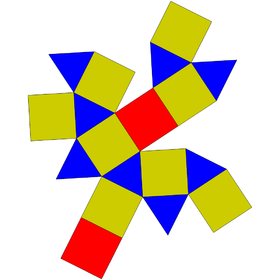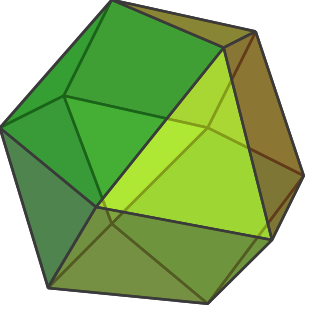
A cuboctahedron is a polyhedron with 8 triangular faces and 6 square faces. A cuboctahedron has 12 identical vertices, with 2 triangles and 2 squares meeting at each, and 24 identical edges, each separating a triangle from a square. As such, it is a quasiregular polyhedron, i.e. an Archimedean solid that is not only vertex-transitive but also edge-transitive. It is radially equilateral.

In geometry, the square cupola the cupola with octagonal base. In the case of edges are equal in length, it is the Johnson solid, a convex polyhedron with faces are regular. It can be used to construct many polyhedrons, particularly in other Johnson solids.

In geometry, the elongated square cupola is one of the Johnson solids. As the name suggests, it can be constructed by elongating a square cupola by attaching an octagonal prism to its base. The solid can be seen as a rhombicuboctahedron with its "lid" removed.
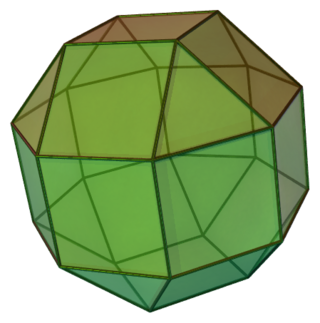
In geometry, the elongated square gyrobicupola is a polyhedron constructed by two square cupolas attaching onto the bases of octagonal prism, with one of them rotated. It is also known as pseudo-rhombicuboctahedron because many mathematicians mistakenly constructed a rhombicuboctahedron. It is not considered to be an Archimedean solid because it lacks a set of global symmetries that map every vertex to every other vertex, unlike the 13 Archimedean solids. It is also a canonical polyhedron.

In geometry, the square orthobicupola is one of the Johnson solids. As the name suggests, it can be constructed by joining two square cupolae along their octagonal bases, matching like faces. A 45-degree rotation of one cupola before the joining yields a square gyrobicupola.

In geometry, the elongated pentagonal gyrobirotunda or elongated icosidodecahedron is one of the Johnson solids. As the name suggests, it can be constructed by elongating a "pentagonal gyrobirotunda," or icosidodecahedron, by inserting a decagonal prism between its congruent halves. Rotating one of the pentagonal rotundae through 36 degrees before inserting the prism yields an elongated pentagonal orthobirotunda.

In geometry, the elongated pentagonal orthobirotunda is one of the Johnson solids. Its Conway polyhedron notation is at5jP5. As the name suggests, it can be constructed by elongating a pentagonal orthobirotunda by inserting a decagonal prism between its congruent halves. Rotating one of the pentagonal rotundae through 36 degrees before inserting the prism yields the elongated pentagonal gyrobirotunda.
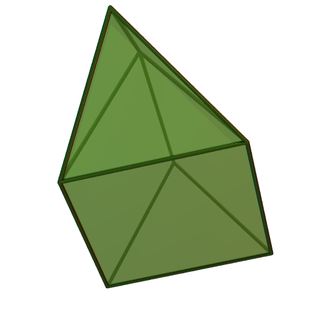
In geometry, the elongated triangular pyramid is one of the Johnson solids. As the name suggests, it can be constructed by elongating a tetrahedron by attaching a triangular prism to its base. Like any elongated pyramid, the resulting solid is topologically self-dual.

In geometry, the elongated square pyramid is a convex polyhedron constructed from a cube by attaching an equilateral square pyramid onto one of its faces. It is an example of Johnson solid. It is topologically self-dual.

In geometry, the elongated square bipyramid is the polyhedron constructed by attaching two equilateral square pyramids onto a cube's faces that are opposite each other. It can also be seen as 4 lunes linked together with squares to squares and triangles to triangles. It is also been named the pencil cube or 12-faced pencil cube due to its shape.

In geometry, the elongated pentagonal cupola is one of the Johnson solids. As the name suggests, it can be constructed by elongating a pentagonal cupola by attaching a decagonal prism to its base. The solid can also be seen as an elongated pentagonal orthobicupola with its "lid" removed.

In geometry, the gyrobifastigium is the 26th Johnson solid. It can be constructed by joining two face-regular triangular prisms along corresponding square faces, giving a quarter-turn to one prism. It is the only Johnson solid that can tile three-dimensional space.

In geometry, the pentagonal orthobicupola is one of the Johnson solids. As the name suggests, it can be constructed by joining two pentagonal cupolae along their decagonal bases, matching like faces. A 36-degree rotation of one cupola before the joining yields a pentagonal gyrobicupola.

In geometry, the elongated pentagonal orthobicupola or cantellated pentagonal prism is one of the Johnson solids. As the name suggests, it can be constructed by elongating a pentagonal orthobicupola by inserting a decagonal prism between its two congruent halves. Rotating one of the cupolae through 36 degrees before inserting the prism yields an elongated pentagonal gyrobicupola.

In geometry, the elongated pentagonal gyrobicupola is one of the Johnson solids. As the name suggests, it can be constructed by elongating a pentagonal gyrobicupola by inserting a decagonal prism between its congruent halves. Rotating one of the pentagonal cupolae through 36 degrees before inserting the prism yields an elongated pentagonal orthobicupola.

In geometry, the elongated triangular cupola is one of the Johnson solids. As the name suggests, it can be constructed by elongating a triangular cupola by attaching a hexagonal prism to its base.

In geometry, the triangular orthobicupola is one of the Johnson solids. As the name suggests, it can be constructed by attaching two triangular cupolas along their bases. It has an equal number of squares and triangles at each vertex; however, it is not vertex-transitive. It is also called an anticuboctahedron, twisted cuboctahedron or disheptahedron. It is also a canonical polyhedron.

In geometry, the elongated triangular orthobicupola is a polyhedron constructed by attaching two regular triangular cupola into the base of a regular hexagonal prism. It is an example of Johnson solid.
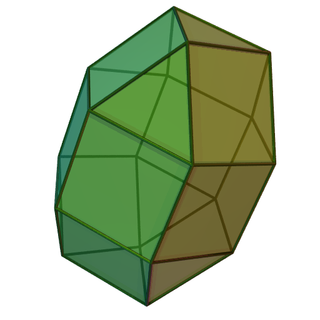
In geometry, the elongated triangular gyrobicupola is a polyhedron constructed by attaching two regular triangular cupolas to the base of a regular hexagonal prism, with one of them rotated in . It is an example of Johnson solid.
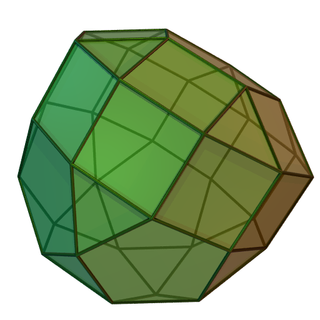
In geometry, the elongated pentagonal orthocupolarotunda is one of the Johnson solids. As the name suggests, it can be constructed by elongating a pentagonal orthocupolarotunda by inserting a decagonal prism between its halves. Rotating either the cupola or the rotunda through 36 degrees before inserting the prism yields an elongated pentagonal gyrocupolarotunda.

